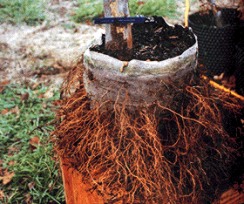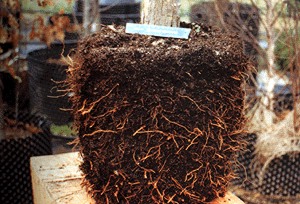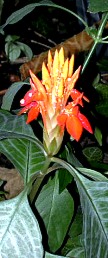|
|
Whitcomb - Nursery Practices 2
Suppose
you could marry the good news aspects of both field and container
production. Would you do it?
With the latest
technology, not only is this possible, it is one of the most economical
and efficient production methods when all factors and costs are
considered, and involves less risk and less labor.
|
|
Here is what
I would do, and why. However, giving all the details would make
a far longer article than is desirable, so here is the essence of
the method. The long version will be available in the revised version
of my book Production of Landscape Plants, available soon
as a hardcover book or as a CD.
The basis of
the system is to work with the plant and avoid restrictions to growth.
Remember a plant runs on energy, and the more productive the leaves
at manufacturing the energy needed for growth of tops and roots,
the better. Avoid the common mistakes that limit growth by techniques
such as treating water to lower bicarbonates, applying modest rates
of low water-solubility herbicides so as to avoid root damage, focus
on the entire nutrition of the plant, because it is how all the
essential elements work in concert that counts, not just the effect
of one or two elements, and so on.
Consider the
following steps:
- Plant seed
in RootMaker
tm propagation
containers. This destroys the taproot within a few days after
germination and stimulates secondary root branching by air-pruning
the roots not only on the bottom but on the sides. It creates
a root system with root tips ready to grow radially as well as
downward when transplanted. Done properly and in a timely manner,
root systems far superior to those that occur in nature can be
produced faster and more consistently. (This procedure also works
for cuttings.)
- Transplant
the seedlings after 10-16 weeks into one- or three-gallon RootMaker
tm containers, which continues the air-root
pruning for the full height of the container sidewall to stimulate
root branching, and accelerates plant growth. Or transplant seedlings
into knit bags held in the cavities of cinderblocks. or into the
five-gallon RootMaker tm Grounder
if your soil drains well.
- Leave all
but the most aggressive side branches on the young trees. Continue
this, leaving all lower limbs and foliage, for the first two growing
seasons or longer. Remove the lower limbs only after good stem
strength is achieved, or roughly one growing season before experience
teaches you that the trees are to be sold at two- to three-inch
stem diameter. The lower limbs on young trees are the main contributors
of energy to boost stem diameter and root growth.
- Prepare
field soil by testing for nutrient levels, and make adjustments
for anything that is deficient or in excess. Till the soil deeply
to improve aeration and supply oxygen for root growth.
- During September
or October of the first year, plant the vigorous, good quality
seedlings into the field to grow on. Throw the runts away. Remember,
it is better and cheaper to throw any marginal liner away at this
point than to grow it on for one or two more years before having
to dispose of it as a cull.
- Plant the
trees in the field in fabric containers made of the latest knit
fabric grow bag technology available from Rootmaker Products Company.
All openings in this special knit fabric are 5/64 inch in diameter.
This is the smallest opening through which the roots of a woody
plant will grow.
As soon as the the root increases even slightly in diameter it
is girdled.
- Drip-irrigate
the first year and whenever rains are lacking in successive years
if good quality water is available.
- Fertilize,
control disease
and insects just as you would with conventional field production.
- Three-inch
caliper trees can be grown and harvested with ease in an 18-inch
diameter knit fabric container. When the
trees reach market size, harvest while they are dormant
(the time when demand for labor is lowest).
- Harvest the
trees using a double loop nylon strap around the trunk and a lifting
arm on a tractor or skid loader. Working with one helper, I have
harvested 80 dormant trees of roughly three-inch caliper in one
hour with this method. Roots that have grown through the knit
fabric container break at the outside face of the fabric as the
tree is pulled from the ground.
-
Strip
away the fabric. The knit fabric comes off far more easily than
the early versions of grow bags.
 
Here's where the marriage comes in ...
1 |
Next (3)
|


